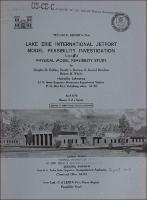Please use this identifier to cite or link to this item:
https://hdl.handle.net/11681/13146| Title: | Lake Erie international jetport model feasibility investigation. Report 17-2, Physical model feasibility study |
| Authors: | Lake Erie Regional Transportation Authority Outlaw, Douglas G. Durham, Donald L. (Donald Lee) Davidson, D. Donald Whalin, Robert W. (Robert Warren) |
| Keywords: | Airports Hydraulic models Lake Erie Physical models Hydrodynamics |
| Publisher: | Hydraulics Laboratory (U.S.) Engineer Research and Development Center (U.S.) |
| Series/Report no.: | Technical report (U.S. Army Engineer Waterways Experiment Station) ; H-74-6 rept. 17-2. |
| Description: | Technical Report Abstract: This report presents the conclusions and recommendations of the U. S. Army Engineer Waterways Experiment Station's study of the feasibility of using physical hydraulic models to estimate the effects of the proposed Lake Erie International Jetport on lake hydrodynamics. This report is the second of a series to be published under the general title "Lake Erie International Jetport Model Feasibility Investigation." The physical models considered in the study are mass circulation, wave action, breakwater stability, and longshore littoral transport models. For circulation models, similitude requirements, scales, model verification, and advantages and limitations are considered for (1.) a rotating lake model, (2.) a rotating model of a section of the lake near Cleveland, and (3.) a nonrotating model of a section of lake near Cleveland, all with wind-driven circulation. A fourth circulation model, similar to (3.), with slope (gravity) currents is also discussed. Wave action models considered are (1.) a model of the entire jetport project and (2.) models of the jetport perimeter corners and shore connections. Recognized concepts for the perimeter dike enclosing the jetport are described and the perimeter dike is divided into reaches for 2- and 3-dimensional model tests of stability against wave attack. Specific models are recommended for investigation of the modification of wave conditions along the shore due to the jetport and for evaluation of breakwater stability. However, a specific physical model for investigation for mass circulation is not recommended prior to the completion of a numerical circulation study, another task in the model feasibility study. If a physical circulation model is required, a vertically distorted rotating model of the lake with wind-driven circulation is recommended. A non-rotating standing wave model of the lake is recommended, again dependent on the results of the numerical circulation model, for investigation of seiche currents near the jetport. A small-scale pilot model is recommended to optimize construction and operating techniques for both the rotating circulation and standing wave models. A longshore littoral transport model is not recommended due to the composition of the shoreline bluffs near Cleveland and the difficulty in modeling cohesive soils. Eddy and wake formation in a physical circulation model with slope currents is discussed in Appendix A. Appendix B is a glossary of hydraulic terms used in this report, and Appendix C is the Notation. |
| Rights: | Approved for public release; distribution is unlimited. |
| URI: | http://hdl.handle.net/11681/13146 |
| Appears in Collections: | Technical Report |
Files in This Item:
| File | Description | Size | Format | |
|---|---|---|---|---|
| TR-HL-74-6-Report-2.pdf | 10.48 MB | Adobe PDF |  View/Open |